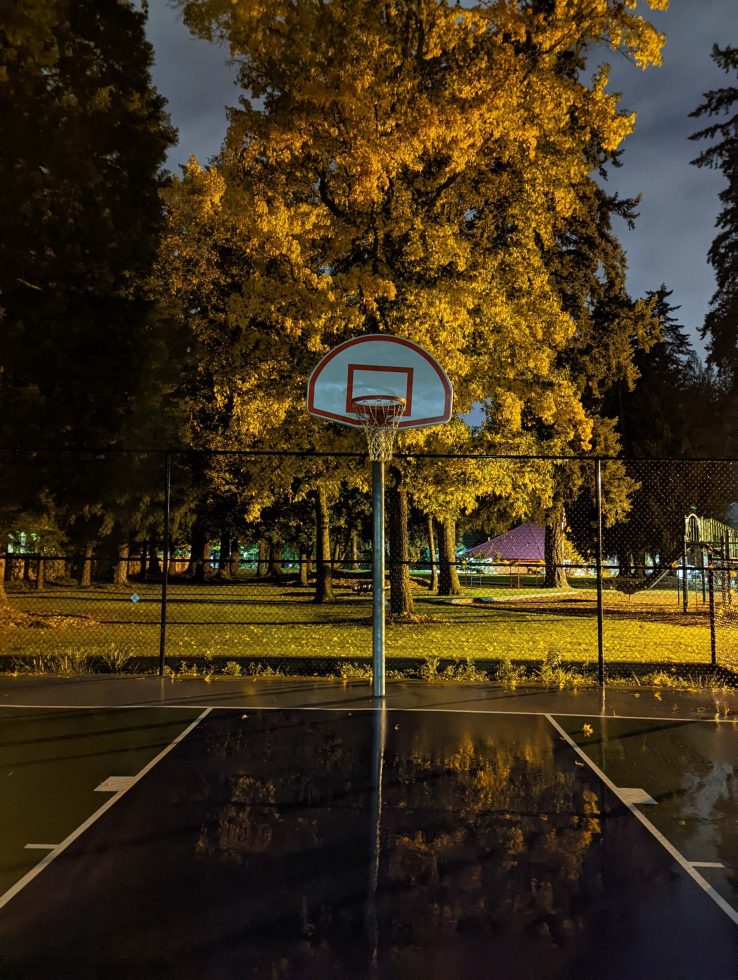You’ve probably read this several times now, but the Pixel 6 Pro sure looks like a phone that Google would make if they were truly going for it. I think they even told us that that’s what this phone is all about, it’s just that in this world of tech, we hear that phrasing or line far too often only to be let down. This time, though, I think Google actually did go for it and what they came up with is a phone that will be impossible to ignore for a number of reasons. It may end up being the phone that tops your list as you look to upgrade over the coming months.
I’ve had the pleasure of using the Google Pixel 6 Pro for about two weeks now and certainly have some thoughts to share on that idea above, and also much more. We need to talk about things like this striking design, those new cameras, Android 12, the size, and of course, price.
For the first time in a long time, there is an abundance of excitement surrounding a Google phone launch, so let’s not waste anymore time. This is our Pixel 6 Pro review.
What do I like about the Pixel 6 Pro?
Android 12 and software. In most reviews, we start with hardware and specs and batteries and cameras, but the Pixel 6 Pro is a showcase for Android like Google has never had before and so that’s where we need to start. Android 12, for those who haven’t used it, is so freakin’ good. This is the most polished, personal, and complete Android has felt.
Obviously, the new look for Android 12 (“Material You”) is front and center, with wallpaper theming that gives you a unique look at any moment as well as bubbly buttons and fat sliders that are playful, if not a bit cartoonish at times. Even the animations from the notification shade to icon exiting to unlocking your phone or plugging it in, are wonderful to watch and toy with. The Android 12 on Pixel phones is without a doubt its own unique skin and I happen to love it.
But this isn’t just about the look of the system theme. Google has already updated the majority of its apps to feature new Material You design details, there are new widgets with each app update that finally give Android the widgets it deserves, and Google is really trying to add-on “advanced” type features to make their Android experience as robust as Samsung’s.
While Google has a long way to go to match Galaxy phones, I’m talking about all the gestures (Quick Tap, One-handed mode, and a customizable power button), universal search throughout the phone’s contacts and apps and settings, scrolling screenshots, and icon theming. But Google also has a few of its own tricks, like Extra Dim, copy and paste and sharing and Google Lens from the app switcher, its At A Glance widget that helps you manage your day, and a clean and clear Security dashboard, as well as a Privacy page. For so long, Google’s Pixel phones felt bare bones at times and with the Pixel 6 and Android 12, I’m having the level of fun browsing through settings that I typically only do with Samsung’s latest.
Google is putting a huge emphasis on the smarts and on-board computing of the Pixel 6 Pro too, all of which help round out this Android 12 experience. Google Assistant can be triggered from new places, the Assistant is better than ever in Gboard at taking your speech and turning it into text (it’s seriously magical), and Live Translate and Live Caption will forever blow my mind with the speed at which they work in real-time.
I haven’t even mentioned software support, which Google has now expanded for these Pixel 6 phones. Not only will you get 3 years of OS updates (that should mean Android 15), you also get a full 5 years of monthly security updates. On top of that, Google issues Pixel Feature Drops several times throughout each year that include new features that are typically exclusive to Pixel phones, at least for a while. Yes, we would have loved to get 4 or 5 years of OS updates since Google is using its own Tensor chip, but there still should be improvements beyond those 3 years, assuming the Feature Drops continue.
I’ve spent way too much time talking about Android 12 and the software of the Pixel 6 Pro, but I really think it is the star of the show. When someone is switching from another Android phone or an iPhone, I think most will find the experience so satisfying, from the smoothness to the touch experience to the feature set to the interface. This is not only the best Android experience, it’s the best smartphone experience. And yes, I’m well versed on iOS – I’ve been using an iPhone 12 and now iPhone 13 Pro for months out of the past year. Android 12 on the Pixel 6 Pro is easier to use than iOS, it looks better, and I’d argue that it’s smoother and more pleasant to the touch.
The camera. For the first time since the Pixel 3, Google gave us a new 50MP main camera sensor in the Pixel 6 and Pixel 6 Pro, tossed in a secondary 12MP ultra-wide, and then rounded things out with a 48MP (4x) telephoto lens. This is a complete revamp of the Pixel camera system and it is a winner.
Google has once again given us their excellent Night Sight mode for dark shots and shooting the stars, there are quick buttons for jumping between focal lengths, a best-in-class portrait mode is here, and we even have really fun new Action Pan and Long Exposure modes. Google’s camera app still lacks a manual mode, but there are enough modes to get you impressive shots without doing any work while also having some room to tweak things like exposure and white balance.
These cameras can snap quickly with the best of ’em and process those tough night shots with a decent pace, the live HDR will forever be impressive, giving you a view of what the camera is about to do to a shot before you snap it, and the main sensor is large enough that you get a natural, soft bokeh without that extra processed or fake look. Since this camera shoots at f/1.85, you can almost shoot realistic portrait shots without using Google’s Portrait mode.
I know that other phones have done the telephoto thing (including Google on the Pixel 4), but the 48MP lens on the 6 Pro is one I’ve really come to enjoy. The amount of detail that Google is preserving at not only 4x, but also with the 20x digital zoom is so impressive. This lens will be fun to use for previously out-of-reach objects and portrait shots going forward, as well as macro situations. I know this camera doesn’t have an official macro mode, but look at a couple of our sample shots to see that it is quite capable.
Overall, this camera excels in the day and then continues to impress when it gets dark. I wish the camera would open a bit quicker, but once you have it open, Google has given you a camera experience that has handy modes, flexibility depending on your situation, and snaps as fast as your finger can tap.
Below, I have example shots taken from the Pixel 6 Pro that have been resized to better fit the site. If you want to see the full-size shots, as well as many more that I didn’t include, here is a Google Photos album to look through.
We’ve also done comparisons of the Pixel 6 Pro to the iPhone 13 Pro and the Pixel 6 to the Pixel 5 that you’ll really want to checkout. These will show you exactly how Google’s new cameras stack up to some of the best options out there.
The specs. Google went for it with the Pixel 6 Pro and specs, giving us an on-paper list of items that doesn’t cut any corners. You have their first processor in Google Tensor, a massive 6.7″ QHD AMOLED display with 120Hz refresh rate, 12GB LPDDR5 RAM, up to 512GB of UFS3.1 storage, 5000mAh battery with 30W wired and 23W wireless charging, IP68 water and dust resistance, stereo speakers, WiFi 6E, UWB, 5G, and a brand new camera setup with wide, ultra-wide, and telephoto lenses.
What’s missing? I can’t think of a thing. We’ve moved on from headphone jacks, SD card slots, and removable batteries, so that leaves nothing. Google did what we’ve all wanted with their Pixel 6 Pro.
This design. The Pixel 6 Pro has its own unique look, like many of the Pixel phones did in years before the Pixel 5. With that said, it’s hard for me to tell you that this is a beautiful phone or an ugly one, because I’m not really sure how I ultimately feel about its looks. I love the changing of shades between panels and that Google didn’t cram a rectangular shaped camera housing in the top left corner of the backside like every other smartphone maker has done for the past two years. I love that they attempted to make these phones different.
The weight balance for such a large phone is spot on, even with that large camera setup. The curves all around make it easy to hold and grip, and the power button and volume are in familiar places that are easy to reach.
However, it’s going to take more than a couple of weeks to figure out what in the hell Google was doing here or if I truly like it. There’s that massive camera bar at the top, which at least stretches the width of the phone, so you can set it down without wobbles. But that camera housing also makes the phone awkward to pull in and out of a pocket. These phones are glossy as hell too, so there is no hiding of your greasy fingerprints (at least on the black model). Google also put a non-matching matte plastic patch on the top of the phone to give it full 5G support.
The design is going to help Google’s Pixel 6 line standout and create a conversation. Whether that’s good or bad is going to be up to each person’s eye. All I can say is that I appreciate the effort to be different and I may be starting to come around to this vibe.
Display. It’s a big one! The large 6.7″ QHD AMOLED display and its curved edges are the star of this show as you scroll about, take in Android 12, watch videos, view all of the fabulous photos you took, and play Pokemon Go. The 120Hz refresh rate makes everything ridiculously smooth in almost all situations, even if it is variable and can drop to 10Hz. For the most part, I only notice it being buttery smooth.
Google is also still giving you dark mode controls, night light filters, and three color profiles. Those three color profiles are hardly different, though, and they don’t actually show a difference if you switch between Natural and Boosted, which is pretty funny. Google also isn’t giving you any true controls over display calibration, so Adaptive is about your best bet and you basically have to trust that Google has tuned this display properly. Speaking of adaptive, it has Adaptive Brightness as well, that will hopefully learn from your usage patterns to automatically adjust the screen at the right time without your manual input.
Thankfully, the display looks pretty good. The colors I’ve seen are exactly as I expected them to look. The display has a good balance between warm and cool tones and touch responsiveness is about as good as it gets in a smartphone. I think this phone is as fast to the touch as any I’ve used.
The display isn’t perfect by any means. I’m worried that brightness won’t be adequate in sunnier climates. Portland has been mostly rainy and dark lately, but I can tell you that I’ve been running the brightness slider in the top third for most of my testing to get it at a comfortable level. I believe it has an outdoor super brightness mode that can automatically kick in, I just haven’t been able to witness it. But like in previous Pixel phones, Google may not have given us brightness that can match Samsung’s phones.
Oh, you want thoughts on the side curves? I was one of the first humans on the planet to be anti-curved display, so I’m not a fan of these either. They aren’t the most dramatic of curves and I haven’t found them as annoying as some older curved phones, but we really could have done without them. Sure, they look cool in photographs and feel smooth to the touch, but they add unfortunate glares at times and can make for a finicky experience if you need to swipe any OS elements that are close to the sides.
The display on the Pixel 6 Pro is certainly an above average display that is propped up by that 120Hz refresh rate and its responsiveness. Its colors are tuned properly, viewing angles are solid, and it gets plenty dim. I do think Samsung still and probably always will have Google beat, though.
Performance. There is a lot riding on the performance of the Pixel 6 Pro because Google tossed in its first smartphone chip, Tensor. Google is claiming this as a “custom-made processor” and that makes the 6 Pro its “most powerful yet.” It should be 80% faster than the Pixel 5, which isn’t saying much knowing the mid-tier processor used in that phone, but Google is trying to deliver improved performance in things like on-device AI and computational photography, as well as efficiency.
Since we aren’t a site that cares much about benchmarks, my thoughts in this area with any phone almost always fall back to how the phone works in daily usage. What I can tell you with the Pixel 6 Pro, through Tensor and its 12GB RAM, UFS3.1 storage, and 120Hz display, is that it’s a speedy, smooth device no matter the task.
There aren’t stutters. Frame drops are rare. Apps open at blazing speeds. The camera snaps as fast as your finger can touch the shutter button. Google Assistant is as quick as can be. Nothing I’ve thrown at this phone has slowed it down. I hammer on the phone with Chrome and Twitter and Instagram and YouTube and Telegram and Duo and Google News and the WHOOP app and security camera apps and weather apps and Spotify and so on. I feel like I’m a typical, if not slightly-heavy smartphone user, and again, this phone hasn’t had an issue with anything I’ve tried to do.
Now, I’m aware of some users complaining about the Pixel 6 Pro heating up, but I’ve only noticed rare instances. Mostly, I notice heat when using Duo and on a long call. Otherwise, the 6 Pro has run pretty normal.
For now, Google Tensor seems like a solid chip that hasn’t offered a bunch of trade-offs from Qualcomm’s chips and has at least given Google an extra 2 years of comfort with security updates. Hopefully, we see future uses and improvements out of this chip as Google continues development.
Price. The price of the Pixel 6 Pro is kind of insane. A starting point of $899, for all that you are getting, doesn’t really make any sense (in a good way) in 2021. The two phones the 6 Pro compares to are the Samsung Galaxy S21 Ultra and iPhone 13 Pro Max, which cost $1,199 and $1,099 to start, respectively. And when you compare Google’s new flagship to those in specs and features and support, it’s not like it comes up short in a major way. If you are an Android user, I’m not sure why you wouldn’t save the $400 and ignore the S21 Ultra. If you are looking at an iPhone or Android device, the $300 savings over Apple’s best has also got to be incredibly tempting. The Pixel 6 Pro is without a doubt the best value in smartphones.
What don’t I love about it?
Size. For the most part, I enjoy everything about the Pixel 6 Pro, if that wasn’t obvious. There is one area of concern, though, and I know I’m likely in the minority, but this phone is too f*cking big. In years past, Google gave us regular and XL versions of its Pixel phones, where they mostly matched up specs to give you a very similar experience no matter the size. It was wonderful for those of us who aren’t fans of carrying around whales or tablets when on the go. For the Pixel 6 Pro, there is only one “pro” model and it is supersized.
Again, I know I’m probably a small portion of the world who hates massive phones. Google and other manufacturers haven’t spent the past several years making these large devices because they felt like it. No, they did it because that’s what consumers buy. I get that. Still, as a person who tries to lead a somewhat active life, a phone this large is almost out of the question. I can’t take this on runs. I would hesitate to take it on a hike. Going out to grab a beer or to play soccer with my kid or to workout in a non-padded room or to leave the house in workout shorts or without a case would all put me in a position to wonder what I’d do with my phone during that time.
That feeling sucks! I like this phone a lot and would love to continue using a Pixel 6 Pro going forward, but man, why couldn’t we get a smaller version too, Google?
Battery life. Before you get super concerned at seeing battery life down here in this section, chill for a second. Battery life on the Pixel 6 Pro is probably going to be fine for most people. At 5000mAh and with 30W wired or 23W wireless charging options, you should make it through most days without needing a charger, but could always top off pretty quickly if needed.
In my first week of testing (with 120Hz on, because yes), battery life was all over the place for me. I had days where I’d go to bed with 15% and then another day where I would have 15% at 7PM. I ran a factory reset a few days ago, removed a couple of apps I was worried about (Eufy!), and I’ve seen much better battery life since. We’re talking 30%-40% battery at bed time with around 4 hours of screen on time. That’s solid!
If you are a monster user, with 6 or 7 or 8 hours of screen on time, I’m not sure this phone is going to get you through a day. I have had readers already suggest they are pushing those limits and seeing good numbers, I just haven’t from my usage patterns. Thankfully, again, Google has upped the charging speeds to 30W with a compatible charger that you would have to buy separately, so as long as you are within reach of an outlet, you should be OK.
NOTE: Charging tests have now confirmed that the Pixel 6 Pro doesn’t actually charge at 30W and instead tops out at about 22W for the first 50% of a charge. After that, it severely tapers charging speeds, causing full charges to take upwards of 2 hours. That’s not good.
The Pixel 6 Pro is not a king in battery, but it’s also not a major area of concern.
Fingerprint reader. For the first time in one of its own phones, Google used an in-display fingerprint reader. This is of the optical kind, where the sensor lights up to blast your finger in order to read and scan it. OnePlus has used these forever, but companies like Samsung have moved onto ultrasonic, which typically present more consistent results and without the beaming light.
The fingerprint reader on the Pixel 6 Pro is…yeah, it’s pretty bad. We called this out on day 1 and there hasn’t been an improvement since. I’ve used it before and after a factory reset, as well as the same reader on a Pixel 6, and the experience is always the same. The reader is slow to read, sometimes forgets that it’s supposed to read your finger mid-read, and successfully scans at a percentage far below 100%. If you press firmly onto your display, you can sometimes get better results, but that’s not a fun experience either. You shouldn’t have to work this hard to get into your phone with a feature that at one point was a major security convenience and has now turned into a nuisance.
Look, I don’t like in-display fingerprint readers of any type. I think they are all slow and bad and no fun and I wish companies would just keep putting them on the backs of phones (or in side power buttons), like Google did with the excellent Pixel 5 fingerprint reader. They don’t want to for design purposes, and I get that, but Google should have done better. You hope that maybe a software update can tweak an algorithm or the light needed to better scan a finger, there’s just no word on if that’s possible. If anything, Google just needs to give us face unlock, so that we can ignore this fingerprint reader whenever we aren’t on the streets with a mask on.
Other notes:
- No charger!: The Pixel 6 Pro is capable of 30W wired charging speeds, and that’s super cool, but there isn’t a charger in the box. I know a lot of people are mad about this and I’m starting to come around to being with you. As I’ve tested this phone, I kind of wanted to get in some 30W charging action, yet can’t because I don’t have a 30W charger handy. Boo, Google.
- Cases: There are a number of case options for this phone, with Google, Bellroy, Spigen, and many others all making theirs available at launch. While I can’t imagine using a case on this phone knowing that it would go from whale to mega-whale, it’s also a necessary item on a $900 phone made of glass. Just know that if you do use a case, most are adding substantial thickness, as they try and make up the difference on the back and its camera hump. That leaves you with protection and no hump, but an even thicker, larger feeling phone.
Videos
Unboxing
First 10 Things To Do
Should you buy a Pixel 6 Pro?
The Google Pixel 6 Pro should be topping your Android smartphone list today if you are in the flagship market. And even if you aren’t, because most flagship phones require a budget of $1,000 or more, this phone can still be in consideration as it starts at just $899.
For years and years the smartphone flagship-level world has trended upwards in price as component costs have gone up and more advanced features are included. To see Google undercut everyone by this margin and not follow that trend is some crazy sh*t. I don’t know if they are taking a hit on the 6 Pro or not, but what I do know is that this is such an incredible value for a phone today.
The display is excellent. Performance is too. The camera matches up with the best in the business. Android 12 with Google’s Pixel skin on top makes for such an enjoyable experience. Performance is great. Battery life is fine. And you get it all without any weird corners cut, outside of maybe the bad fingerprint reader.
If you are fine with a phone this large, buy it.





Collapse Show Comments73 Comments